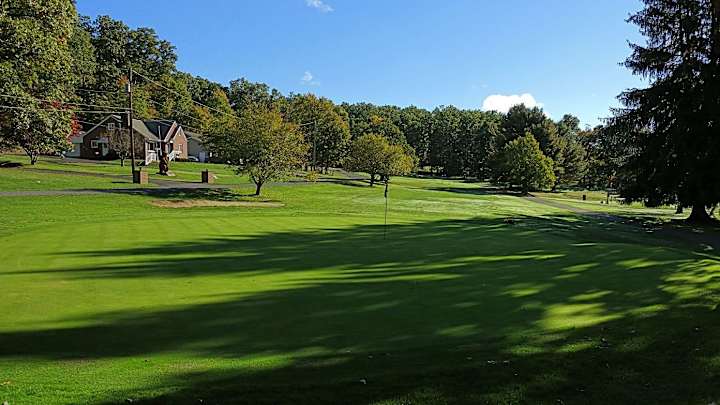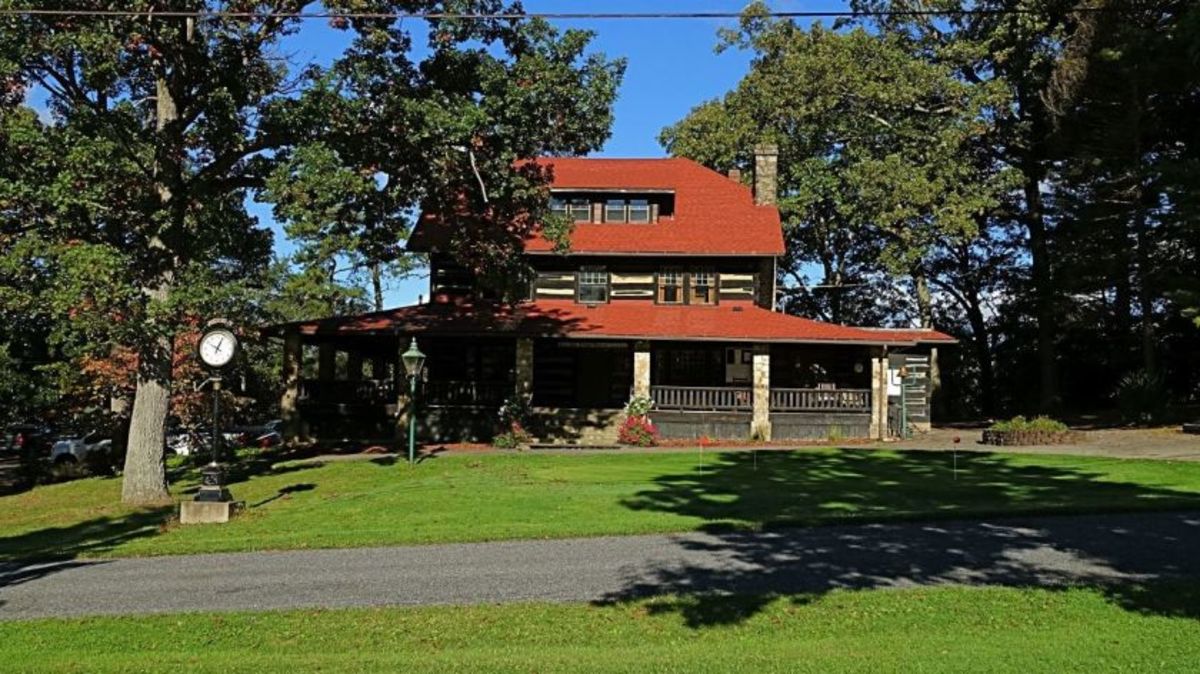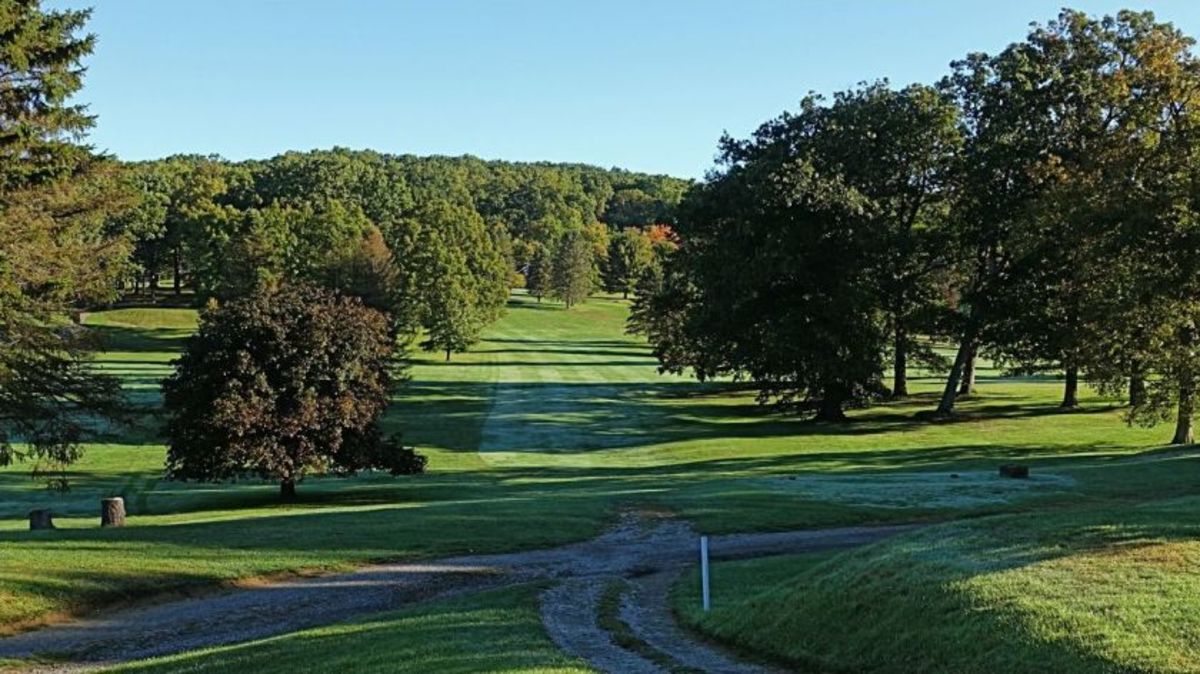Foxburg Country Club: History abounds in Pennsylvania hills

Foxburg Country Club had me at hello.
I recently made a 75-minute drive north from Pittsburgh, turned left into a parking lot by a time-worn log cabin clubhouse and parked by a sign that read, “Welcome, Foxburg Country Club, Established 1887.”
Eighteen eighty-seven? Buffalo Bill toured Europe with his Wild West show that year, Nikolai Tesla experimented with what he would later call X-rays and Grover Cleveland served the first of two non-consecutive terms as U.S. President, still the only man to accomplish that.
I came to this course in tiny Foxburg, Pa., population 175, high on a bluff above the Allegheny River’s east bank, to experience golfing history.
The reason the course is here, I later learned, is Old Tom MorrisOld Tom Morris, the famed golfing Scot who lived and died in St. Andrews. Old Tom won the British Open four times in the 1860s, the last at age 46. He still reigns as the oldest Open champion 150 years later.
Morris didn’t design Foxburg but he got Joseph Mickle Fox hooked on golf. Fox was the son of a Philadelphia family that earned its fortune in real estate and oil.
Fox was a star cricket player for Philadelphia’s exclusive Merion Cricket Club, which traveled to Great Britain for a series of matches against squads from England, Ireland and Scotland. A stop in Edinburgh led to a visit to St. Andrews, where Fox met Old Tom and became enthralled by golf. Morris instructed Fox on some fundamentals of how to play and built him some lefthanded clubs.

Upon returning home, Fox laid out eight makeshift holes around the family mansion. This new game of golf proved so popular that Fox ordered right-handed clubs shipped from Scotland for his friends and created a five-hole course on pasture land outside the estate grounds. The following year, Fox expanded it to nine holes (and later donated the land to the town).
Thus, Foxburg was off and running. But without Old Tom and his chance meeting with Fox, the club might never have been born and I wouldn’t be in this parking lot 133 years later.
The clubhouse is a three-story log cabin with a cozy bar and a shady front porch. It’s not the original, which was erected in the early 1900s and was very small. The current edition was a member’s summer home bought by the club in 1941. Its early pioneer look adds to the feeling of antiquity.
Foxburg claims to be the oldest continually operating course in the U.S. So does Vermont’s Dorset Field club, founded in 1886 (but not incorporated into a club until the 1890s) and St. Andrews of New York, started in 1888. West Virginia’s Oakhurst Golf Links is considered America’s earliest course. It began in 1884 but closed in 1912 and didn’t reopen until a 1994 restoration.
So who’s really No. 1? Let’s not debate, let’s celebrate them all.
I met Foxburg member Andy Rapp by the old clock in front the clubhouse. “I think you’re gonna like it here,” he said. Did he mean the history or the course? It didn’t matter, he was right on both counts.
Rapp had invited me to be part of his three-man team in a scramble outing with Superintendent’s Revenge-style conditions — pins set in crazy-impossible places. It was a great opportunity to see the course and experience the greens at their toughest. Our trio didn’t have to invoke the event’s double-bogey maximum score limit but we came close a few times.
The beauty of Foxburg is its simplicity. It is a relic of another time in golf and golf-course design. There are only nine holes but a different set of tees for use the second time around means it adds up to 5,253 yards of par-68 fun. Is it too short? Only if you hate maybe shooting a few strokes lower than usual. Short doesn’t necessarily mean easy.

For example, the opening hole is a straightaway, downhill par 4 of 309 yards. Our scramble team used my drive, which finished atop the shelf just a few yards short of the green. Don’t be impressed. Western Pennsylvania had a lengthy late summer drought in August and September. The ground was extra-firm and golf balls rolled extraordinary distances. I liked that.
My drive left the team with a difficult chip to a pin beyond a ridge. We made a birdie but we didn’t have a tap-in. The hole looks like a pushover but it isn’t.
The first impression of Foxburg is that it is unspectacular, almost bland. It’s supposed to be unspectacular. This is golf from the 19th century. There are no waterfall holes or three-tiered greens. The course has slopes and there are enough well-positioned trees to make it strategic. If Foxburg CC is a plain Jane, then so is Jane Fonda.
Here’s the lay of the land: The clubhouse is near the top of a hill. The six holes that aren’t par 3s line up like a row of ducks along the slope, going uphill or downhill. Even though many par 4s are short by today’s standard, it’s rare to have an approach shot from the same elevation as the green, adding a subtle degree of difficulty. Two par 3s (Nos. 2 and 8) are on the property’s low end. The other, No. 6, is atop the hill and plays toward the clubhouse.
There are other highlights.
The Beast of Foxburg: It is the third hole, a 374-yard par 4 that plays uphill and bends slightly left. A couple of large trees stand guard in the left rough and tree trouble lurks if you bail out way right, too. The green has a slight false front atop a sharp slope and is guarded by two small bunkers. It’s not an easy shot even with a perfect drive. Drive it behind the trees on the left, as I did the second time around, and we found out it’s not even an easy bogey hole.
The birdie hole: The par-5 fifth hole should be reachable in two even if you don’t drink protein shakes like Bryson DeChambeau. It’s only 435 yards from the white tee but that tee is tucked into the trees, forcing a golfer to play a substantial fade to find the fairway. It’s 50 yards longer from the blue tee but maybe easier because the tee offers a straight shot up the hill. There’s a catch. The right rough is loaded with trees, which sneakily harbor out of bounds stakes. So there’s an element of danger for those who hit it left-to-right, which is practically everybody.
The memorable hole: The par-3 sixth plays somewhere around 150 yards. The green has a severely raised edge around the left side and the back. It’s a pretty hole late in the day with long shadows from a tall stand of trees behind the green. Superintendent Jeff Texter, in his 43rd year on the job, unleashed his inner Dr. Evil on this hole for the outing. The cup was placed near the top of the slope very near the green’s left edge. Any missed putt rolled back 15 feet toward the center of the green. We two-putted for par once and three-putted for bogey once and didn’t feel bad about ourselves. In accordance with a common Scottish trait, each hole at Foxburg has a name. The sixth is Putter’s Grief.

The timeless hole: The seventh felt like 19th-century golf more than any other. It is a 310-yard par 4 that plays downhill along the entrance road. Two intimidating, angled mounds sit 25 yards in front of the green and they are covered in hairy rough. The green is drivable if a pseudo-DeChambeau can hit one straight, but the putting surface slopes so sharply back to front that any drive would surely careen beyond it.
Dr. Evil was still thirsty for our blood, apparently, because this cup was near the peak of the green’s slope so just like the sixth hole, any missed putt acted like a bowling alley ball return. Our group was on in two, 20 feet away. Three tries later, we were on in three, 20 feet away. It was about to get ugly when my partners missed again and I yanked my putt left and hit it too hard — but wait. The ball rolled above the hole, reversed course and trickled backwards, drifted right and dropped in. Welcome to Dr. Evil’s Mini-Golf House of Pain.
Rapp said the superintendent considered double-cutting the greens for this outing but decided against it. After the seventh, we agreed he made the right call.
The annoying hole. The ninth is a driver-wedge play of 317 to 335 yards, leaving an uphill lie to a small green that is not flat. Hit the green, it’s a tough two-putt. Miss the green, it’s an awkward chip and a tough one-putt. It shouldn’t be a bogey hole and yet…
There is history on every Foxburg tee. Each one has a hand-cut stone trough, called a “sandbox” in its day. One part is filled with sand, the other with water. Golfers or their caddies mixed the ingredients to make a tee to hit from, a kind of sandcastle building. Wooden tees didn’t exist yet. It was the first time I’d seen a sandbox and Foxburg has nine such rarities. It was a simple thing, yet I admit I got a few goose bumps.
The topper is the clubhouse’s upper two levels, home to the American Golf Hall of Fame. Several rooms are filled with displays, photographs, artifacts and old clubs. The evolution of the golf ball has samples of balls as they improved from a pouch filled with feathers (a “featherie”) to gutta percha, then rubber and eventually to today’s solid-core balls. There are hickory-shafted clubs to examine and much more. It’s no wonder Foxburg is listed in the National Registry of Historic Places.
My favorite artifact was a large black-and-white photo of grizzled, bearded Old Tom Morris himself, looking determined as he played the game he loved and having no idea he’d ultimately impact a tiny Pennsylvania village thousands of miles away.
On the drive back to Pittsburgh that evening after an eventful day, I was still thinking about the trove of antiquities I’d seen when I missed my exit off of I-80 and was re-routed. The ensuing detour added half an hour to my ride home.
I was annoyed at first but then I realized, 30 minutes were nothing compared to Foxburg’s 133 years.
Sign up to receive the Morning Read newsletter, along with Where To Golf Next and The Equipment Insider.
